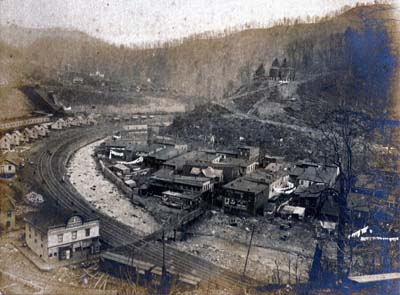From the Bottom Up
Cinder Bottom's Red Light District
By Katherine R. Spindler

This photo from Sodom and Gomorrah of Today (1912) offers a bird’s-eye view of Keystone. Note the coal operations, coke ovens, and company
houses on the left across Elkhorn Creek. Courtesy of the Eastern Regional Coal Archives, Kraft Memorial Library, Bluefield.
In its heyday in the early 20th century, Cinder Bottom—a small section of Keystone in McDowell County—was known regionally, nationally, and even internationally for its infamous red light district. Railroads arranged special routes around coal miners’ vacations, dead bodies supposedly were found on the streets weekly, and World War I soldiers stationed in France shared stories about their adventures in Cinder Bottom. Cinder Bottom even gets a chillingly memorable mention in John Sayles’ film 1987 Matewan.
Despite its fame, though, the power players of this mini-sin city have remained a mystery. In a town that thrived on illegal businesses, who truly ran the show?
Perhaps the first question should be, “Why was prostitution allowed to thrive so openly in McDowell County?” The most obvious answer involves so-called dirty cops. In his book Bloodletting in Appalachia, former state Attorney General Howard Lee recounted his 1909 visit to Keystone, where he watched the chief of police beat a madam. According to Lee, the madam had resented the chief’s unexpected visit because it wasn’t time yet for his next bribe.
A Welch attorney, Mr. Hassan, recalls the Cinder Bottom brothels from childhood and explains that the police payoffs actually regulated criminal activity to some extent. Police tended to protect illegal businesses that paid their bribes regularly. For instance, many cops would step in to stop violence against prostitutes because it would draw undue attention to the payoffs and those who ran illegal prostitution, gambling, and drinking rings.
Surprisingly, some coal companies encouraged—and perhaps controlled—Cinder Bottom’s illicit activities based on the theory that satisfied workers were more productive. But, the biggest mystery revolves around a question Lee asked the chief of police, “Who owns these dives?”
The chief’s response? “That is a matter that is never discussed.”
The answer likely lies in the overlooked role of women—and, in this case, prostitutes—in the southern coalfields. As playwright and historian Jean Battlo remarks, “These were hard-core, hard-headed businesswomen with a sense of capital. Only opportunity, education, gender, and class prevented them from competing with the local coal barons for the legitimate economic leadership of the region.” [See “Cinder Bottom: A Coalfields Red-Light District” by Jean Battlo, Summer 1994.]
Madams and sex workers had to operate profitable businesses while using their legal and political savvy to stay out of jail. These stories, which are documented in the depths of the McDowell County Courthouse, show that prostitutes relied on various methods—from evasion to political maneuvering—to prosper in Cinder Bottom’s vice economy.
Through evasion, prostitutes could avoid criminal liability by disassociating themselves from their businesses. Few brothel workers were West Virginia natives. Of the 17 women who lived in Mary Dickerson’s brothel in 1910, only three were from West Virginia; 11 hailed from Virginia, and the rest came from Kentucky and Georgia. There were no West Virginia natives among the eight adult women living in Ella Kelsaw’s brothel: half were from Virginia and the rest from Pennsylvania, Tennessee, and North Carolina. Thus, sex workers could maintain a certain level of anonymity by moving around from town to town.
In addition, even when prostitutes more or less settled down in one place, they didn’t work for just one madam. A 1909 charge cited Blanche Miller as loitering in Ada Nichol’s “house of ill fame”; yet, by the following year, she was living in Kelsaw’s boardinghouse. Likewise, Marie Marshall resided in Kelsaw’s boardinghouse in 1910 but, according to an indictment, was living in Dickerson’s brothel two years earlier.
It made sense for prostitutes to change locations frequently or separate their workplaces from their living spaces. This made it less likely to get charged for living, boarding, or loitering in a house of ill fame. It also made it more difficult for a madam to be charged with a crime when the other women residing in the house actually worked in a separate brothel.
So, why would some madams risk owning their own brothels? On the surface, it doesn’t seem like the benefits of ownership would override the potential criminal liability. The answer, however, seems to be very simple: money. Ownership provided madams with at least two sources of incomes: the prostitution business plus rent.
You can read the rest of this article in this issue of Goldenseal, available in bookstores, libraries or direct from Goldenseal.